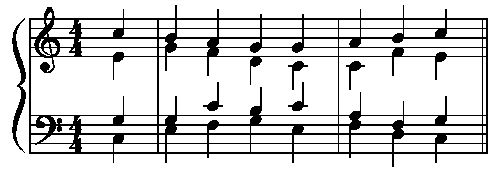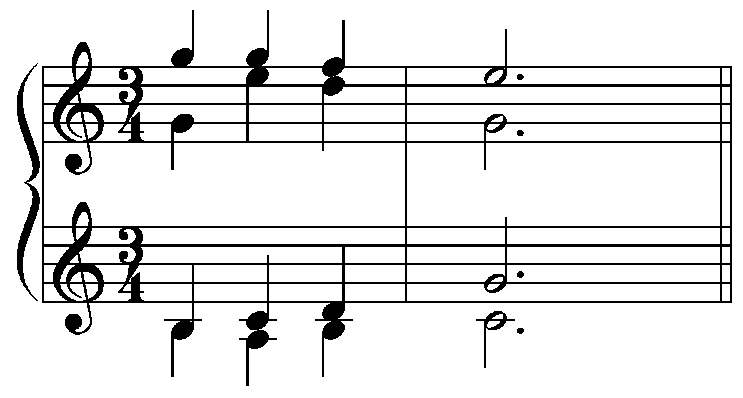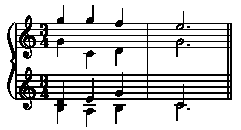#D4
.>.?0 "W+[+\#\9 "[0W#?0<K
_>_?9 _$+]9\+$0 _]+:+?9<K

8.1. When two or more notes of the same value are sounded together, forming a chord, one note only is written according to Table 1, the remainder being represented by the signs in Table 8 which indicate their distance, or interval, from the written note.
8.2. The direction in which intervals are to be read (upward or downward from the written note) depends very much on the instrument for which the music is written, and on the disposition of the score. In general, it may be said that the melody and the bass should each appear as written notes. Where clef signs are used, the treble clef implies a downward reading and the bass clef an upward reading of intervals.
(When it is desired to reverse the usual normal practice in reading intervals and in-accords in any part, one of the following indications
7Y/ EQUALS
Y<>Z<K7
7Y/ EQUALS Y<>)<K7
should be placed at the beginning of the piece. Where necessary,
this indication can be preceded by a hand sign, the initials of
an instrument, etc.)
Example 8.2-1.
#D4
.>.?0 "W+[+\#\9 "[0W#?0<K
_>_?9 _$+]9\+$0 _]+:+?9<K

(See also Par. 20.4, 26.8, 28.11-28.12.)
8.3. When the written note is
dotted, it is not necessary to place dots after any intervals
(but see Example 8.8.4-1).
Example 8.3-1.

8.4. Intervals larger than the
octave are expressed by the same series of signs preceded by an
appropriate octave mark, the 9th corresponding to the 2nd, the
10th to the 3rd, and so on.
Example 8.4-1.
#C4
.>.\_0\_3]_9 .P'"+<K

8.5. The octave rules for chords of more than two notes are as
follows:
8.5.1. If more than one interval
follows the written note, no octave mark is needed so long as any
two adjacent intervals are less than an octave apart.
Example 8.5-1.
#C4
.>.\-0\-3]39 .P'0+<K

Example 8.5-2.

8.5.2. If any two adjacent intervals are an octave or more apart, the second interval must
have its proper octave mark.
Example 8.5.2-1.

8.5.3. If an interval forms a
unison with the written note, it is shown as an octave preceded
by its proper octave mark.
Example 8.5.3-1.

8.5.4. If an interval forms a unison with another interval the second interval must have its proper octave mark.
(N. B. In the last two chords of
the following example the inner parts form an octave in the one
case and a unison in the other).
Example 8.5.4-1.

8.5.5. When two parts represented by intervals cross one another
in a chord, each note that is, so to speak, out of place must
have its proper octave mark, the written order of the parts
however remaining unchanged.
Example 8.5.5-1.

8.6. Tone clusters are notated in many
different ways, but usually the top and bottom pitches are
written as if they are pitches in a chord. Between the two
pitches, a vertical line, box, thick bar, or other shape
indicates the cluster. Accidentals or printed words may or may
not accompany the cluster.
8.6.1. According to the proper direction of intervals, the top or
bottom pitch is written followed by the cluster sign and an
interval sign showing the other outside pitch.
| (a) | _>'*^I^*B*- | 
|
| (b) | .>.\^%B"/ |  |
| (c) | .>.Q^5B- |  |
Doubling of Intervals
8.7. When more than three successive notes are followed by the same interval or intervals not modified by accidentals or other signs, such intervals may be doubled.
Example 8.7-1.

8.7.1. If, during a passage of such doubling, any doubled
interval, except for octaves, is modified, the doubling of that
interval must be re-marked where the accidental occurs if its
continuance is justified. Thus, the doubling of an interval may
be initiated, as well as re-marked, at the point of modification,
provided that the modified, doubled interval is followed by at
least three unmodified, like intervals. Doubling which is in
progress must also be restated when yet another interval warrants
doubling under the usual conditions. If, during said passage, any
doubled interval is terminated, the doubling of any other
interval should be terminated simultaneously, unless its
continuance is justified, in which case the interval is redoubled
at that point, thus:

8.7.2. When greater-than-octave intervals are
involved, it is inadvisable to use any doubling of intervals
whatsoever. The necessity to insert appropriate octave marks for
each such interval, in the absence of intermediary intervals,
would usually negate any supposed saving of space.
Example 8.7.2-1.
_>.C^(99D_/Y_/.CY_/D93Y-<K

8.7.3. In a passage of doubled octaves the doubling need not be
interrupted by the occurrence of accidentals which would normally
be marked for the octave as well as for the written note.
Example 8.7.3-1.

8.7.4. All doubling of intervals legitimately in effect at the
end of the previous page should be restated at the beginning of a
new page, assuming that at each instance there are a sufficient
number of notes to warrant such doubling. Thus, doubling will not
be started at the bottom of the page unless it can legitimately
be in effect on that page, nor will it be employed at the top of
the page if the usual conditions do not prevail. 8.7.5. In fingered music it is not advisable to double any other
interval than the octave unless every note of the passage is
fingered or unless the fingering is so placed that there can be
no possible doubt about the notes to which it belongs.
(See also Par. 15.2.1 and Example 17.5-1.)
8.8. The moving-note device, although
infrequently employed, is chiefly useful for vocal music and
keyboard settings of hymns. Complications of fingering, phrasing
and nuances render it unsuitable for instrumental music in
general. (In the following example the first two intervals are halves and
the remainder quarters).
8.8.1. When two, or at most three, notes of equal value move
below or above a longer note, they can be written as intervals
separated by dot 6.

8.8.2. The moving-note sign can also be used when two or more
intervals move together in a similar manner but in this case dots
5-6 must be substituted for dot 6.

8.8.3. The marking of octaves in the moving
part is governed by the rule given in Par. 8.4. Compare (a) and
(b) below.
| (a) | .>.]'-,<+,-$'0,+,*9<K |

(b) .>"G<.E"GH.D*I<K

8.8.4. The moving-note sign can also be used for a dotted quarter
and eighth, etc., but is not recommended for such a rhythm as
that shown at (b) below.

(b) Bad: .>"P+,#'Q0,9'
"&+<K

The doubled moving-note sign (dots 5-6) must never be used for
such dotted rhythms.